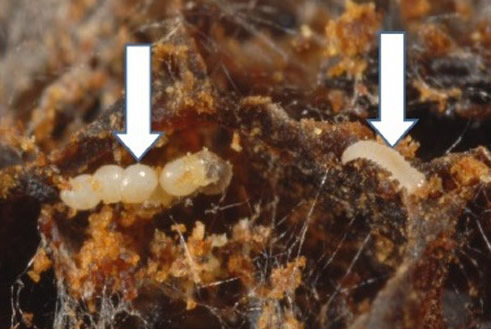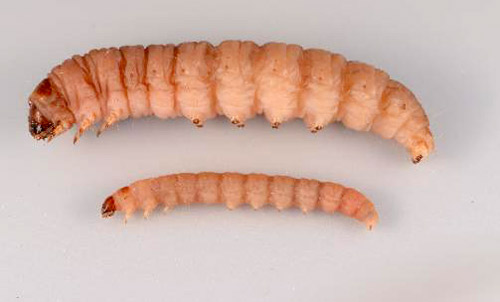common name: lesser wax moth
scientific name: Achroia grisella Fabricius (Insecta: Lepidoptera: Pyralidae)
Introduction - Distribution - Description and Life Cycle - Economic Importance - Management - Selected References
Introduction (Back to Top)
Achroia grisella Fabricius, the lesser wax moth (Figure 1), is considered a pest of unoccupied honey bee, Apis spp., hives and stored hive materials. However, wax moths can be considered beneficial insects in wild/feral colonies because they destroy combs that remain after a colony of bees dies or abandons the nest site. These abandoned combs potentially harbor pathogens and/or pesticide residues that have been left behind by the previous colony. Wax moths consume the abandoned combs, thereby minimizing the risk for exposure to future inhabitants of the cavity. Lesser wax moths have a similar life history to that of greater wax moths, Galleria mellonella L.
Figure 1. An adult lesser wax moth, Achroia grisella Fabricius, on a piece of brood comb. Photograph by Mike Bentley, University of Florida.
Distribution (Back to Top)
Lesser wax moths are cosmopolitan in distribution, and are present nearly anywhere honey bees are managed. The lesser wax moth is more successful in warmer tropical and subtropical climates, and cannot survive long periods of freezing temperatures. However, the lesser wax moth can survive at higher latitudes and lower temperatures than can the greater wax moth.
Description (Back to Top)
Eggs: Adult females typically lay eggs in protected crevices near a food source. The eggs are creamy white and spherical (Figure 2). The time it takes for eggs to hatch is variable, with warmer temperatures leading to faster development for all life stages. Eggs typically take five to eight days to hatch.
Figure 2. Eggs (left) and a first instar (right) of the greater wax moth, Galleria mellonella L., shown here due to the lack of images of lesser wax moth, Achroia grisella Fabricius, eggs and first instar larvae. Lesser wax moth eggs are very similar to the eggs of the greater wax moth. Photograph by Lyle Buss, University of Florida.
Larvae: The larvae have narrow, white bodies with a brown head and pronotal shield (Figure 3). Larval development can take between one and five months, at an average of six to seven weeks at 29° to 32°C. The larvae undergo seven molts. Most of the larval growth happens within the last two instars and mature larvae are approximately 20 mm long. Larvae tunnel through beeswax comb spinning tunnels of silk, which they cover in frass (feces). The larval stage is the only life stage that eats. Larvae typically consume comb containing bee brood (honey bee larvae and pupae), pollen, and honey. Larvae prefer brood and pollen comb to virgin and/or honey comb. However, lesser wax moths are often found feeding on the hive floor because greater wax moths outcompete them for the desirable brood comb in areas where both species co-occur.
Figure 3. Late instar greater wax moth, Galleria mellonella L., larva (top) and lesser wax moth, Achroia grisella Fabricius, larva (bottom). The two species are similar in appearance with the major difference being size. Photograph by Lyle Buss, University of Florida.
Pupae: Mature larvae will pupate anywhere in the honey bee hive and spin tough silk cocoons around themselves prior to pupating. Pupae are approximately 11 mm long and a yellow-tan color. Cocoons are white and have webbing holding them in place. It can be difficult to identify cocoons as they often are covered in frass and other debris. Pupae can take up to two months to mature, but the average time to adult emergence is about 37 days.
Adults: Lesser wax moth adults are approximately ½ inch long and have slender bodies. Their wingspan is approximately ½ inch wide. Generally, males are smaller than females (Figure 4). Their coloration ranges from silver-gray to beige and they have a prominent yellow head. Adults live approximately one week and are most active at night. Mating typically occurs within honey bee hives and males attract females to mating sites with ultrasonic signals. Females also lay their eggs at night. During the day, adults remain hidden in trees and bushes near hives.
Figure 4. Comparison of female (left) and male (right) lesser wax moths, Achroia grisella Fabricius. Photos are at the same scale. Note that the male is smaller than the female. Photograph by Lyle Buss, University of Florida.
Economic Importance (Back to Top)
The lesser wax moth is a secondary pest of honey bee colonies, in that they only become a nuisance to colonies that are weakened already by another factor(s), such as a failing queen, pathogens, poor nutrition, and/or primary pests like Varroa and small hive beetles.
Lesser wax moth larvae may cause a disorder called bald brood (Figure 5). Bald brood occurs when the larvae tunnel under the capped cells of honey bee pupae. Worker bees find the damaged cappings and chew away what remains of the cap, exposing the developing honey bee pupae. Uncapped pupae usually occur in a line tracing the path of the moth larvae. The moth larvae also can leave fecal matter on the honey bee pupae.
Figure 5. Bald brood caused by a wax moth infestation. Note how the wax cappings have been removed from selected cells and the pupae within those cells are visible. Photograph by Ashley Mortensen, University of Florida.
Lesser wax moths are most damaging in stored comb that is not protected by resident bees (Figure 6). Beekeepers who do not take precautions to prevent wax moth infestations may find their stored combs infested with wax moths. Lesser wax moth eggs can be deposited around honey bee products, such as pollen and comb honey, before their removal from the colony. These eggs can hatch and the resulting larvae make the products unsellable. This can be avoided by beekeepers if they freeze hive products to be used for human consumption for at least 24 to 48 hours.
Figure 6. Wax moth damage to wax comb. The damage is the result of wax moth feeding, larval webbing, and frass. Photograph by Lyle Buss, University of Florida.
Beekeepers consider lesser wax moths a pest, but the moths can help decrease honey bee diseases in natural settings. Invading wax moths remove the comb left by the bees in abandoned hives, leaving a clean cavity for a new colony to inhabit. In fact, the introduction of wax moths into New Zealand correlated with the reduced prevalence of American foulbrood (National Bee Unit 2010), a serious bacterial disease of bees caused by Paenibacillus larvae and harbored in old combs.
Lesser wax moths are also raised commercially as animal feed, fish bait, and models for scientific research. Lesser wax moths larvae are even suitable for human consumption.
Management (Back to Top)
There are several lesser wax moth management options for beekeepers. The most important aspect of managing lesser wax moths is to maintain healthy, robust honey bee colonies. Strong hives seldom have issues with moths and other secondary pests because worker bees kill and/or evict lesser wax moth larvae and seal areas where adult moths may lay eggs.
In contrast, lesser wax moths can cause significant damage to stored wax combs. Fortunately, there are several ways to store wax comb to limit lesser wax moth damage. Either extreme heat or cold will kill all life stages of lesser wax moths, including eggs that may be hidden from view. It is possible to kill lesser wax moths at temperatures of 114°F and above, noting that wax comb melts at 119°F. Freezing is a better choice for treating wax combs. All lesser wax moth stages will die when maintained at 20°F for 24 to 48 hours. After freezing, the materials can be stored in airtight plastic bags to prevent re-infestation. Cold rooms maintained at approximately 39°F also may be used to store materials. At 39°F, the lesser wax moths are not killed, but their activity is severely decreased and damage is minimal.
Good ventilation and direct light can reduce lesser wax moth populations in stored products. Beekeepers can store hive boxes stacked at right angles, in well-lit, highly ventilated areas (such as open-walled sheds). Dark combs (comb in which bee brood has been raised) cannot be stored this way.
Fumigation is a less desirable, more expensive treatment for lesser wax moths in stored hive materials. Chemical fumigation cannot be used on honey comb the beekeeper plans to sell or consume. In the U.S. several chemical fumigants currently are registered for use on honey bee hive materials for control of wax moths. Additionally, carbon dioxide fumigation is safe to use on honey comb, but can be extremely dangerous for the user.
Selected References (Back to Top)
- Anonymous. (2010). Wax moth. The Food and Environment Research Agency, New Zealand, National Bee Unit. (3 August 2015)
- Caron DM. 2000. Wax moth. MAAREC (Mid-Atlantic Apicultural Research and Extension Consortium), Publication 4.5. (3 August 2015).
- Charriere J, Imdorf A. 2004. Protection of honey combs from moth damage. Swiss Bee Research Centre, Communication Nr. 24. (3 August 2015).
- Ellis JD, Ellis A. (2013). Aethina tumida Murray (Insecta: Coleoptera: Nitidulidae). Featured Creatures. University of Florida, IFAS, Entomology and Nematology Department, Featured Creatures, EENY-474. (3 August 2015).
- Ellis JD, Graham JR, Mortensen A. 2013. Standard methods for wax moth research. Journal of Apicultural Research 52: 1-17. doi: http://dx.doi.org/10.3896/IBRA.1.52.1.10
- Ellis JD, Zettel Nalen CM. (2013). Varroa destructor Anderson and Trueman (Arachnida: Acari: Varroidae). University of Florida, IFAS, Entomology and Nematology Department, Featured Creatures, EENY-473. (3 August 2015). http://entnemdept.ufl.edu/creatures/misc/bees/varroa_mite.htm
- Goodman R. (2009). Wax moth – A pest of combs and honey bee products. Department of Primary Industries, Victoria, Canada, ISSN 1329-8062.
- National Bee Unit. (2010). Wax moth. The Food and Environment Research Agency, New Zealand,. (3 August 2015)
- Somerville D. 2007. Wax moth. New South Wales Department of Primary Industries Primefact 658. (3 August 2015).
- Williams JL. 1978. Chapter 7: Insects: Lepidoptera (Moths), pp. 105-127. In Morse R. (ed.), Honey bee pests, predators and diseases. Comstock Publishing, a division of Cornell University Press, Ithaca, NY. 732 pp.





